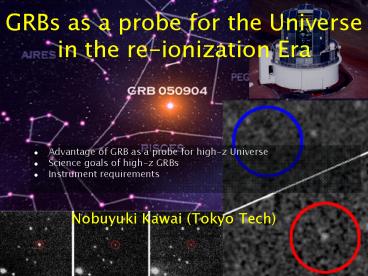Nobuyuki Kawai Tokyo Tech - PowerPoint PPT Presentation
1 / 21
Title:
Nobuyuki Kawai Tokyo Tech
Description:
z~6-20, by first stars/quasars? need to study z 6 !!! How and when ... GRB vs. quasar. White, R.L. et al., AJ 126, 1 (2003) GRB 050904. z=6.295. Subaru FOCAS ... – PowerPoint PPT presentation
Number of Views:173
Avg rating:3.0/5.0
Title: Nobuyuki Kawai Tokyo Tech
1
GRBs as a probe for the Universe in the
re-ionization Era
- Advantage of GRB as a probe for high-z Universe
- Science goals of high-z GRBs
- Instrument requirements
- Nobuyuki Kawai (Tokyo Tech)
2
The Big Question
How and when the Universe was formed?
- IGM was re-ionized by the first generation
luminous objects - reionization at (Page et
al. 2006) - the universe reionized twice? (e.g. Cen 03)
- rapid increase of tIGM at z5 (QSO spectra)
indicates the end of reionization at z6 (e.g.,
Fan et al. 2006) - z6-20, by first stars/quasars?
- need to study zgt6 !!!
3
Objects at high redshifts
- AGN and galaxies
- Sample of only luminous objects
- massive systems (BH or stellar)
- special condensed region in the Universe
- large ionizing flux in X-ray (AGN) or UV (LAE)
- strong effects on ISM and IGM
- Difficult to find
- Require wide field survey
- not only rare, but also cosmic variance
- Less than 10 QSOs at zgt6 out of 200 million
objects in SDSS (1/6 sky)
4
GRB advantage at high redshifts
- GRBs
- No luminosity bias for the host galaxy
- more ordinary galaxy population
- simply tracing SFR
- No proximity effects
- Easy to detect in X/g
- gt15 at zgt5 out of 100 Swift GRBs/yr
- AGN and galaxies
- Sample of only luminous objects
- massive systems (BH or stellar)
- large ionizing flux in X-ray (AGN) or UV (LAE)
- Difficult to find
- Require wide field survey
- Less than 10 QSOs at zgt6 out of 180 million
objects in SDSS (1/6 sky)
5
Record redshifts
(just relatively uncontroversial ones)
quasars
galaxies
Tanvir 2005
6
GRB vs. quasar
weak Ly a emission
GRB 050904 z6.295 Subaru FOCAS
White, R.L. et al., AJ 126, 1 (2003)
7
not-so-luminous host galaxy
i-band (24 ks)
NB921 (56.7 ks)
gt 26.4 AB mag (3s) M1260 gt -20.4 mag ? LltL SFR lt
7.5 Msun/yr
Dec 27 05--Jan 01 06 (t0115119d)
Aoki et al. 2006 (in preparation)
8
Swift is detecting more high-z GRBs
- Swift is detecting 100 GRBs/yr
- 50 with optical/NIR afterglow
- 25 has known redshifts
- out of 42 with known z
- 7 at zgt4
- 3 at zgt5
- 1 at zgt6
- 15 (or more) of detected GRBs likely at zgt5
pre-Swift ázñ 1.4
Swift ázñ 2.8
Lamb, Venice conference (2006)
9
GRB 050904X-ray afterglow
Watson, D. et al. astro-ph/0509640
Watson, D. et al. astro-ph/0509640
10
GRBs probe
- Metallicity
- S/H -1.3 for GRB050904 at z6.3
- xHI IGM neutral hydrogen fraction
- consistent with 0.0 at z6.3 (lt0.6 at 3s)
- SFR as a function of z
- need large sample with known redshift
- Nature of the pop-III stars
- how do they explode?
- SN products (Fe, a-elements) similar to low-z
thermonuclear/core-collapse SNe?
11
GRB 050904 at t3.4 d
z 6.3
Log NHI21.6
z 6.2950.002
S/H-1.3
Kawai et al. (2006) Totani et al. (2006)
Subaru FOCAS 4.0 hrs, l/Dl1000
12
Metalicity vs. Redshift
GRBs DLAs D GRB hosts
M/H
GRB 050904 Kawai et al. 2006
Fynbo et al. 2006 Prochaska et al. 2003 Sollerman
et al. 2005
13
X-ray vs. optical/NIR
- Optical/NIR afterglow detection rate only 50
- X-ray afterglow detection 100
- optical metallicity measurements affected by
dust - some elements condensed in dusts
- X-ray NH tend to be larger than those derived
from optical extinction - low dust formation? metallicity effects?
- Difficult to cover the right wavelengths
- no early NIR spectroscopy of afterglow yet
- e.g. GRB 050904 (S, Si, C, O, but no Fe)
14
X-ray observation goals
- absorption ? Fe/O, redshift
- low-E absorption vs. Fe edge
- low-E NH1022 ? 1-2 keV restframe
- Fe edge 7 keV rest ? 1 keV at z6
- Energy coverage 0.2 keV 1.2 keV
- DE/E 1 eV or less desirable for Fe edge
- Fe line ? redshift, GRB physics, progenitor and
environment - need extremely special setting(geometry, Fe
abundance, )
15
simulation with XRS RMF
0.8
1.2
0.5
2.0
- photon statistics (GRB 050904 with XRS ) 10
- photon index2
- NH 1023 cm-2
- E.W10 eV
- solar abundance
16
GRB070828 ASCA
Yoshida et al. 1999, 2001
Emission-like 5keV
- Consistent z, if interpreted as the radiation
recombination edge
17
GRB970508 Fe line(?)
Piro et al. 1999
E3.400.3 keV (6.20.6 keV at source)
- 97.3 confidence level
- Consistent with optical redshift z0.835
- Before reburst
- Mmin 0.5 Mo AFe1
18
Fe line
- fluorescence from spherical medium
continuum
Fe line
EW 10 (NH/1022) eV (Zsun, 6.4 keV)
1.5 (NH/1022) eV (at z6)
Makino, Leahy and Kawai 1985
19
Fe line
- fluorescence from spherical medium
- Maybe detectable
- at a late phase
- as a orphan afterglow(Fe line transient)
beaming factor 1/100
EW 1.5 (NH/1022) eV x(1/100) (at z6)
20
orphan afterglow event rate
- 2 GRB/day/sky
21
Instrument requirements
- Burst detector
- Trigger capability for long, low-flux, soft
bursts - Spacecraft
- Slew time lt 100 s
- prompt communication to/from ground (lt10 s)
- Anti-sun poiting desirable for ground coverage
- Focal place detector
- lower energy threshold lt0.2 keV (NH at z6)
- upper energy threshold gt1.2 keV (Fe edge at z6)
- DE/E 1 eV (Fe edge and Fe line)
- measurable flux gt 100 mCrab or 1 c/s/cm2 at 1 keV
- low background (for extended observation)
- large W gt 1 deg2 (orphan Fe line transient)
- additional detector (optical/NIR camera?)































